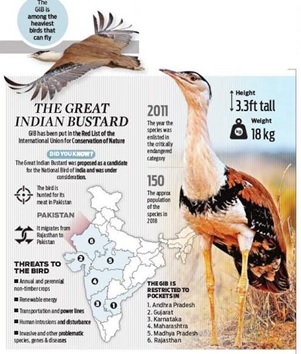

6th April 2022 (7 Topics)
Context
The Supreme Court of India sought an update from the committee formed for making power lines underground in Rajasthan and Gujarat ordered a year ago.
About
The Great Indian Bustard (GIB) or Godavan
- Scientific Name: Ardeotis nigriceps
- Heaviest of the flying birds.
- These birds are often found associated in the same habitat as blackbuck.
- Habitat: Arid and semi-arid grasslands with scattered short scrub, bushes and low intensity cultivation in flat or gently undulating terrain. It avoids irrigated areas.
- Distribution:
- The Species were formerly widespread across India and Pakistan.
- However, at present, its population is estimated to be of less than 200 across Rajasthan, Gujarat, Maharashtra, Madhya Pradesh, Karnataka and Andhra Pradesh.
- Typically, it is found in Kutch (Gujarat), Solapur and Chandrapur (Maharashtra), Kurnool (Andhra Pradesh), Bellary (Karnataka), and in pockets of Rajasthan, primarily concentrated near the Desert National Park (DNP).
Major Reasons for decline in Population:
- Loss of Habitat due to increase in population, agriculture and infrastructure development etc.
- GIBs are large in size and usually take low flights which often result in deaths due to collision with electricity transmission lines.
- The habitat is under threat due to the zigzag web of high-tension power lines through the sacred groves of Jaisalmer.
- Stray dogs which are known to attack the bustard’s eggs and young ones.
Poaching outside the protected areas.
Protected areas dedicated to GIB
- Rajasthan: Desert National Park – Jaisalmer and Balmer
- Gujarat: Naliya Sanctuary in Kutch
- Madhya Pradesh: Karera Wildlife Sanctuary (The species disappeared from Madhya Pradesh in early 90s’)
- Maharashtra: Nannaj Grasslands, Solapur
- Andhra Pradesh: Rollapadu Wildlife Sanctuary
Conservation Status
- Listed under Critically Endangered Category of IUCN Red List.
- Listed in Schedule I of the Indian Wildlife (Protection) Act, 1972.
- It is also listed in Appendix I of CITES.
- Identified for the species recovery program under Integrated Development of Wildlife Habitats Scheme.
- It is declared as state bird of Rajasthan.


